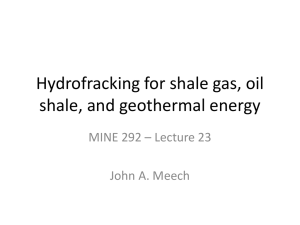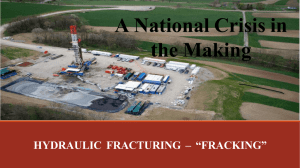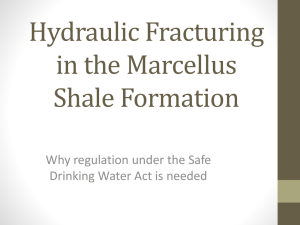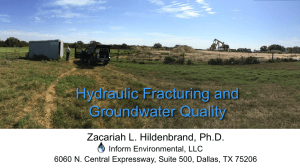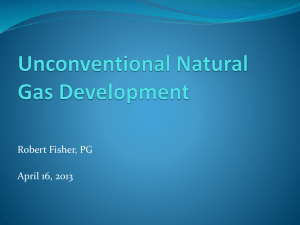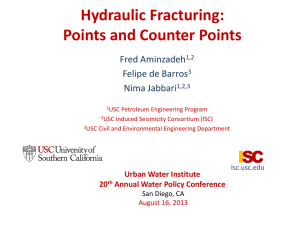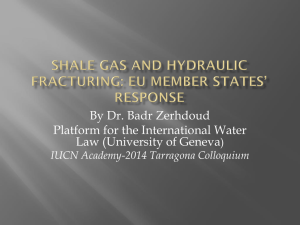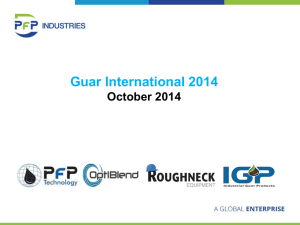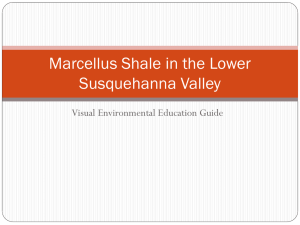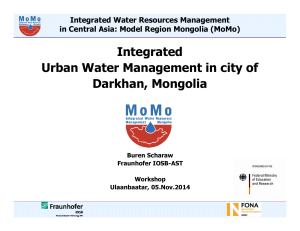Hydrofracking for shale gas, oil shale, and geothermal energy
advertisement
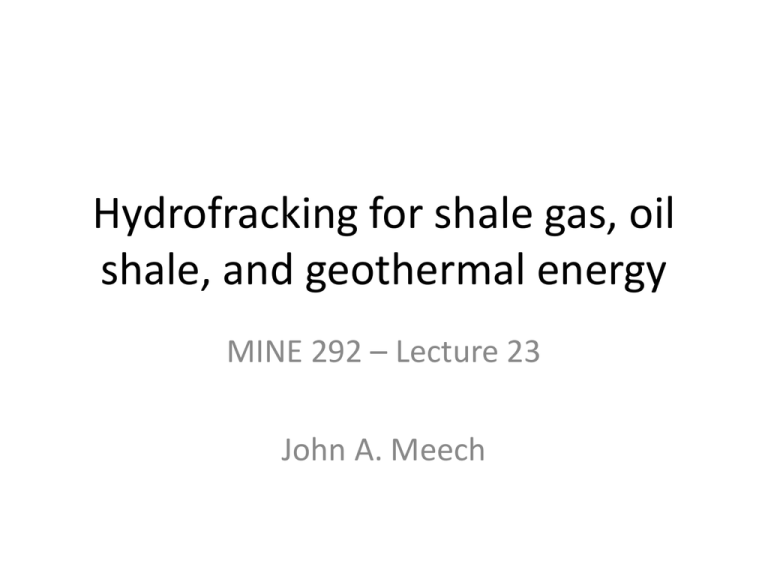
Hydrofracking for shale gas, oil shale, and geothermal energy MINE 292 – Lecture 23 John A. Meech What is Hydraulic Fracturing? • HF is a method to transmit fluid or gas pressure to create cracks or open existing cracks in hydrocarbon-bearing rock to allow gas or oil to flow more freely from the formation to the wellbore • Process is known as Stimulation What is Hydraulic Fracturing? • Method of HF depends on: – – – – – Type of well (vertical or horizontal) Type of well construction (cement/casing) Type of fracturing fluid Cost of method Wells are fractured from 8 to 40 times over their lives • Methods – Pulsed Pressured Water (weeks) – High-pressure liquid propane gel (two days) – Explosives (not for shale gas) Major Concerns • Waste water treatment and disposal • Safety of chemicals used • Possibility of aquifer contamination Fracturing rocks at depth • Suppressed by confining pressure from overlying rock • Tensile fractures require crack surfaces to move apart • Confining pressure prevents movement • Effective stress is reduced by increasing fluid pressure within cracks • Minimum principal stress is in tension and exceeds tensile strength of the material • Fractures are oriented perpendicular to minimum principal stress • Hydraulic fracturing in wellbores sometimes used to determine orientation of principle stresses Fracturing rocks at depth Hydraulic fracturing is also applied: – – – – – – – To stimulate groundwater wells To precondition or induce rock to cave in mining To enhance waste remediation (hydrocarbon waste or spills) To dispose of waste by injection into deep rock formations To measure rock stress To enhance permeability for enhanced geothermal systems To increase injection rates for CO2 sequestration Fracturing rocks at depth • Fluid pressure exceeds pressure gradient of the rock • Proppant used to prevent or slow closure of cracks • silica sand or resin-coated sand • ceramic beads and other particulates • Fluid leaking into permeable rock must be controlled or it may exceed 70% of injected fluid • Fracking is often performed in cased wellbores • Zones to be fractured accessed by perforating casing • Pressures can reach as high as 100 MPa • Injection rates can reach up to 265 L/s Fracturing rocks at depth • High-viscosity fracturing >>> large dominant fractures • 'Slickwater' (high rate) fracturing >>> small dispersed micro-fractures • Fracture fluid contains water-soluble gels (guar gum) to increase viscosity and deliver proppant into formation • Fluid injected into the rock is a slurry of water (90%), proppants (9.5%) and chemical additives (0.5%) • Foams, and compressed gases (N2, CO2 and air) sometimes used Typical Chemical Additives Acids - HCl (5-28%) or acetic acid for cleaning perforations Salt - NaCl to delay breakdown of gel polymers Polyacrylamide - to minimize fluid/pipe friction Ethylene glycol - to prevent scale formation Borates - to maintain fluid viscosity as temperature rises Na2CO3 / K2CO3 - to maintain effectiveness of cross-linkers Glutaraldehyde - to disinfect the water Guar gum (water-soluble gels) - to increases viscosity Citric acid - to prevent corrosion Monitoring • Measure pressure and rate of growth of fracture • Measure properties of fluid and proppant • Model length, width, & connectivity of propped fracture • Inject radioactive tracers to determine profile and locate fractures • Monitor micro-seismicity using geophones to estimate size and orientation of fractures • Install tiltmeter arrays to monitor strain Environment • • • • • • • Practices must become transparent (IP issues) - Huge methane volumes releases Air - 1.2 toxictogases 3.5 M gal/stimulation Water - Europe CO2 is higher due to depth Microseismic events (1.5-3.0) Injected Fluid (chemicals) Very few wells have caused 35 out of 1,000,000 metals, brine, wellsradioactivity have caused Flowback - Dissolved earthquakes of concern - contamination water treatment of required ground water at site Seismicity - Some BC Oil and Gasare Commission chemicals known carcinogens concluded earthquakes - Some chemicals are proprietary Shortand38 long-term exposure to Health Effects from 2.2 to 3.8 air occurred contaminated & waterinand radon Horn River Basin from 2009 to 2011 near pre-existing faults Media Coverage • Gasland - Josh Fox • Truthland - Colorado Oil and Gas Conservation Commission (COGCC) • Promised Land - Matt Damon • Fracknation - Phelim Mcaleer "New" Technologies • Hydrofracking has been in use since late 1940s • Directional-drilling has evolved to an accuracy previously unattainable • "Game-Changer" technology with respect to fossil fuels as an energy source • These are clean techniques – no question • Resistance exists due to "hidden-agendas" Land Disturbance – much reduced 6 wells (8 fracs/well) 48 vertical wells Vertical vs. Horizontal • Alberta – 70% in 2012 • B.C. – 89% in 2012 • Saskatchewan – 60% (2009-12) Natural Gas Sources Shale Gas Shale gas has been produced for over 100 years in the Appalachian and Illinois Basins in the US Hydraulic Fracturing was first used in late 1940s New Drilling technologies has accelerated development and evolution of shale gas World Shale Gas Reserves Shale Gas Reserves – top 15 1. China 2. United States 3. Argentina 4. Mexico 5. Indonesia 6. South Africa 7. Australia 8. Canada 9. Libya 10. United Kingdom 11. Algeria 12. Brazil 13. Poland 14. Pakistan 15. Ukraine 36 Tm3 24 Tm3 22 Tm3 19 Tm3 18 Tm3 14 Tm3 11 Tm3 11 Tm3 8 Tm3 7 Tm3 7 Tm3 6 Tm3 5 Tm3 2 Tm3 2 Tm3 PriceWaterhouseCoopers "By 2035, shale oil production could boost world economy by up to $2.7 trillion. US exports could reach 12% of world’s total oil production — 14M bbl/day revolutionizing global energy markets for many decades" Shale gas exploration has revealed deep underground shale deposits of "tight oil" or shale oil Canadian Shale Gas Equipment Required During Operation Equipment Required During Operation Casing Hydraulic Fracturing First Commercial HF – Oklahoma, 1949 Hydraulic Fracturing Location Relative to Ground Water Location Relative to Ground Water Permeability Ranges • mD = milliDarcy (1 Darcy = 10-12 m2) Permeability and Darcy's Law P x where ν = superficial fluid velocity (m/s) κ = permeability (m2) µ = dynamic viscosity (Pa·s) ΔP = applied pressure (Pa) Δx = thickness of the bed (m) Four Step Process Step 1 • Pressure the reservoir rock using a fluid to create a fracture Step 2 • Grow the fracture by continuing to pump fluids into the fracture(s) Step 3 • Pump proppant materials into the fracture (contained in fracture fluid) Step 4 • Flow-back to the well to recover fracture fluids while keeping proppant in place Perforating Gun Frac-pumping Unit Data Collection Van Proppant Transfer Truck Composition of Fracture Fluid Micro-Seismic Monitoring Data Collection of Micro-seismics Location of Major Shale Gas Resources Shale Gas Resources U.S. Domestic Energy Consumption
